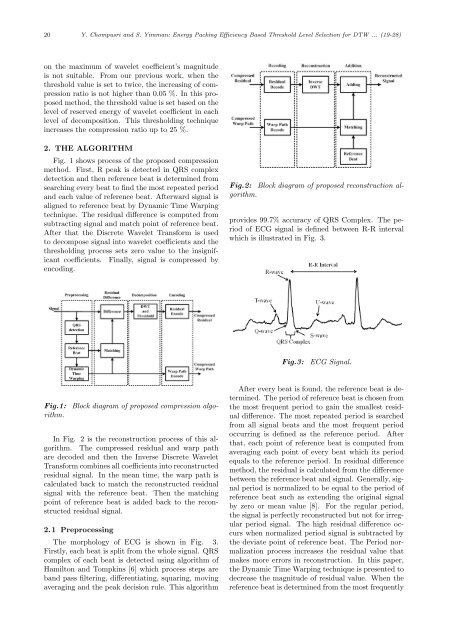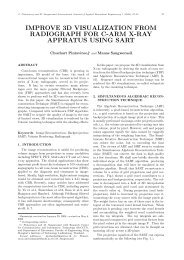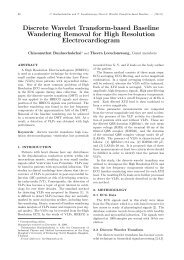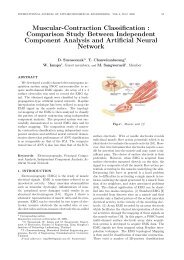Energy Packing Efficiency Based Threshold Level ... - ijabme.org
Energy Packing Efficiency Based Threshold Level ... - ijabme.org
Energy Packing Efficiency Based Threshold Level ... - ijabme.org
Create successful ePaper yourself
Turn your PDF publications into a flip-book with our unique Google optimized e-Paper software.
20 Y. Chompusri and S. Yimman: <strong>Energy</strong> <strong>Packing</strong> <strong>Efficiency</strong> <strong>Based</strong> <strong>Threshold</strong> <strong>Level</strong> Selection for DTW ... (19-28)<br />
on the maximum of wavelet coefficient’s magnitude<br />
is not suitable. From our previous work, when the<br />
threshold value is set to twice, the increasing of compression<br />
ratio is not higher than 0.05 %. In this proposed<br />
method, the threshold value is set based on the<br />
level of reserved energy of wavelet coefficient in each<br />
level of decomposition. This thresholding technique<br />
increases the compression ratio up to 25 %.<br />
2. THE ALGORITHM<br />
Fig. 1 shows process of the proposed compression<br />
method. First, R peak is detected in QRS complex<br />
detection and then reference beat is determined from<br />
searching every beat to find the most repeated period<br />
and each value of reference beat. Afterward signal is<br />
aligned to reference beat by Dynamic Time Warping<br />
technique. The residual difference is computed from<br />
subtracting signal and match point of reference beat.<br />
After that the Discrete Wavelet Transform is used<br />
to decompose signal into wavelet coefficients and the<br />
thresholding process sets zero value to the insignificant<br />
coefficients. Finally, signal is compressed by<br />
encoding.<br />
Fig.2: Block diagram of proposed reconstruction algorithm.<br />
provides 99.7% accuracy of QRS Complex. The period<br />
of ECG signal is defined between R-R interval<br />
which is illustrated in Fig. 3.<br />
Fig.3:<br />
ECG Signal.<br />
Block diagram of proposed compression algo-<br />
Fig.1:<br />
rithm.<br />
In Fig. 2 is the reconstruction process of this algorithm.<br />
The compressed residual and warp path<br />
are decoded and then the Inverse Discrete Wavelet<br />
Transform combines all coefficients into reconstructed<br />
residual signal. In the mean time, the warp path is<br />
calculated back to match the reconstructed residual<br />
signal with the reference beat. Then the matching<br />
point of reference beat is added back to the reconstructed<br />
residual signal.<br />
2.1 Preprocessing<br />
The morphology of ECG is shown in Fig. 3.<br />
Firstly, each beat is split from the whole signal. QRS<br />
complex of each beat is detected using algorithm of<br />
Hamilton and Tompkins [6] which process steps are<br />
band pass filtering, differentiating, squaring, moving<br />
averaging and the peak decision rule. This algorithm<br />
After every beat is found, the reference beat is determined.<br />
The period of reference beat is chosen from<br />
the most frequent period to gain the smallest residual<br />
difference. The most repeated period is searched<br />
from all signal beats and the most frequent period<br />
occurring is defined as the reference period. After<br />
that, each point of reference beat is computed from<br />
averaging each point of every beat which its period<br />
equals to the reference period. In residual difference<br />
method, the residual is calculated from the difference<br />
between the reference beat and signal. Generally, signal<br />
period is normalized to be equal to the period of<br />
reference beat such as extending the original signal<br />
by zero or mean value [8]. For the regular period,<br />
the signal is perfectly reconstructed but not for irregular<br />
period signal. The high residual difference occurs<br />
when normalized period signal is subtracted by<br />
the deviate point of reference beat. The Period normalization<br />
process increases the residual value that<br />
makes more errors in reconstruction. In this paper,<br />
the Dynamic Time Warping technique is presented to<br />
decrease the magnitude of residual value. When the<br />
reference beat is determined from the most frequently











